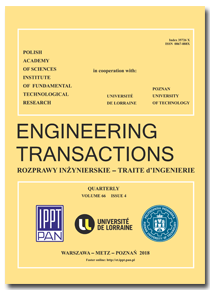10.24423/engtrans.24.2013
An Experimental Study on Rate Sensitivity of J-Integral and its Evaluation by Small Punch Test for TRIP Steel
References
Zackay V.F., Parker E.R., Fahr D., Busch R., The enhancement of ductility in highstrength steels, Trans. ASM, Quart., 60, 252–259, 1967.
Tomita Y., Iwamoto T., Constitutive modeling of TRIP steel and its application to the improvement of mechanical properties, Int. J. Mech. Sci., 37, 12, 1295–1305, 1995.
Rice J.R., A path independent integral and the approximate analysis of strain concentration by notches and cracks, J. App. Mech., 35, 379–386, 1968.
Kobayashi T., Yamamoto I., Niinomi M., Evaluation of the dynamic fracture toughness parameters by instrumented charpy test [in Japanese], Tetsu-to-Hagane, 16, 1934-1940, 1985.
Klepaczko J.R., Discussion of a new experimental method in measuring fracture toughness initiation at high loading rates by stress waves, J. Eng. Mater. Technol., Trans. of ASM, 104, 1, 29–35, 1982.
Xu Z., Li Y., Study of loading rate effect on dynamic fracture toughness of high strength steel under impact loading, Streng. Fract. Compl., 6, 1–2, 17–23, 2010.
Kalthoff J.F., Fracture behavior under high rates of loading, Eng. Fract. Mech., 23, 1, 289–298, 1986.
Bleck W., Schael I., Determination of crash-relevant material parameters by dynamic tensile tests, Steel Research, 71, 173–178, 2000.
Choi I.D., Bruce D.M., Kim S.J., Lee C.G., Park S.H., Matlock D.K., Speer J.G., Deformation Behavior of Low Carbon TRIP Sheet Steels at High Strain Rates, ISIJ Int. J., 42, 12, 1483–1489, 2002.
Yokoyama T., Kishida K., A novel impact three-point bend test method for determining dynamic fracture-initiation toughness, Exp. Mech., 29, 2, 188–194, 1989.
Kobayashi T., Wakai N., Yagi W., Kazino T., Ueda Y., Effects of manganese and nickel increase on mechanical properties of TRIP Steel [in Japanese], Tetsu-to-Hagane, 71, 9, 1178–1185, 1985.
Antolovich S.D., Singh B., On the toughness increment associated with the austenite to martensite phase transformation in TRIP steels, Metall. Mater. Trans. B, 2, 8, 2135–2141, 1971
Mao X., Takahashi H., Development of a further-miniaturized specimen of 3 mm diameter for tem disk small punch tests, J. Nucl. Mater., 150, 1, 42–52, 1987.
Shindo Y., Yamaguchi Y., Horiguchi K., Small punch testing for determining the cryogenic fracture properties of 304 and 316 austenitic stainless steels in a high magnetic field, Cryogenics, 44, 11, 789–792, 2004.
Foulds J., Viswanathan R., Small Punch Testing for Determining the Material Toughness of Low Alloy Steel Components in Service, J. Eng. Mater. Technol., 116, 4, 457–464, 1994.
Budzakoska E., Carr D.G., Stathers P.A., Li H., Harrison R.P., Hellier A.K., Yeung W.Y., Predicting the Jintegral fracture toughness of Al 6061 using the small punch test, Fat. Fract. Eng. Mater. Struct., 30, 9, 796–807, 2007.
Shindo Y., Horiguchi K., Sugo T., Mano Y., Finite element analysis and small punch testing for determining the cryogenic fracture toughness of austenitic stainless steel weld, J. Test. Eval., 28, 6, 431–437, 2000.
Rodriguez-Martinez J.A., Rusinek A., Pesci R., Experimental survey on the behaviour of SISI 304 steel sheets subjected to perforation, Thin-Walled Struct., 48, 12, 966–978, 2010.
Brown W.F., Srawley J.E., Fracture toughness testing, ASTM Spec. Tech Publ., 381, 175–180, 1965
Chuman Y., Mimura K., Kaizu K., Tanimura S., A sensing block method for measuring impact force generated at a contact part, Int. J. Impact Eng., 19, 2, 165–174, 1997.
Rice J.R., Paris P.C., Merkle J.G, Some further results of J-Integral analysis and estimates, ASTM STP536, 231–245, 1973.
Mao X., Takahashi H., Development of a further-miniaturized specimen of 3 mm diameter for TEM disk small punch tests, J. Nuclear Materials, 150, 42–52, 1987.
Nemat-Nasser S., Isaacs J.B., Starrett J.E., Hopkinson Techniques for Dynamic Recovery Experiments, Proc. Roy. Soc. Lond., A, 435, 1894, 371–391, 1991.
Frew D.J., Forrestal M.J., Chen W., Pulse Shaping Techniques for Testing Elasticplastic Materials with a Split Hopkinson Pressure Bar, Exp. Mech., 45, 2, 186–195, 2005.
DOI: 10.24423/engtrans.24.2013




